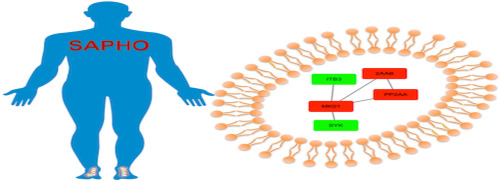当前位置:
X-MOL 学术
›
J. Proteomics
›
论文详情
Our official English website, www.x-mol.net, welcomes your
feedback! (Note: you will need to create a separate account there.)
Exosomal proteome from the serum, bone marrow, and palm and toe pustular skin tissues of a single patient with SAPHO syndrome.
Journal of Proteomics ( IF 2.8 ) Pub Date : 2020-01-27 , DOI: 10.1016/j.jprot.2020.103673 Guomin Liu 1 , Tiancheng Lu 2 , Yalong Li 1 , Yun Liu 3 , Xuan Ji 3 , Wenyuan Jia 1 , Maolei Sun 3 , Yungang Luo 3
Journal of Proteomics ( IF 2.8 ) Pub Date : 2020-01-27 , DOI: 10.1016/j.jprot.2020.103673 Guomin Liu 1 , Tiancheng Lu 2 , Yalong Li 1 , Yun Liu 3 , Xuan Ji 3 , Wenyuan Jia 1 , Maolei Sun 3 , Yungang Luo 3
Affiliation

|
Exosome proteomic analysis may reveal differentially abundant proteins that are of significance for clarifying the pathogenesis of SAPHO (Synovitis, Acne, Pustulosis, Hyperostosis and Osteitis) syndrome. Exosomes were isolated from the serum, bone marrow and skin tissue of the palm and toe pustular areas in a unique patient with SAPHO syndrome. The exosomes were not different from those of healthy subjects in size (114.1 ± 73.7 nm) or morphology. Label-free exosome proteomic analysis identified 198 more abundant proteins and 183 less abundant compared with those of healthy subjects. Gene ontology enrichment analysis revealed that these proteins were involved in binding with a variety of biological molecules and participated in biological processes related to autoimmunity or inflammation. A total of 243 KEGG (Kyoto Encyclopedia of Gene and Genomes) pathways were enriched, of which 43 were related to immune function. It was speculated that five differentially abundant proteins, Mitogen-activated protein kinase 1 (MAPK1/MK01), Tyrosine protein kinase (SYK), Integrin beta-3 (ITB3), Serine/threonine-protein phosphatase 2a catalytic subunit alpha isoform (PP2AA) and Serine/threonine-protein phosphatase 2a 65 kDa regulatory subunit A beta isoform (2AAB), associated with multiple KEGG pathways, forms an interaction network that may be involved in the occurrence, development and prognosis of SAPHO syndrome. SIGNIFICANCE: Exosomes of SAPHO syndrome patient were not significantly different from those of healthy subjects in size and morphology. Label-free proteomic analysis of exosomal proteins in patient with SAPHO syndrome speculated 5 proteins MAPK1, SYK, ITB3, PP2AA and 2AAB, which may be involved in the occurrence, development and prognosis of SAPHO syndrome by binding with other biological molecules. It is speculated for the first time that proteins Histone H2A type 1-J and Histone H4 were related to SAPHO syndrome. Clinic relevance. Exosome proteomics can suggest novel pathological data in patients with SAPHO.
中文翻译:

来自SAPHO综合征的一名患者的血清,骨髓以及手掌和脚趾脓疱皮肤组织的外泌体蛋白质组。
外泌体蛋白质组学分析可能会发现差异丰富的蛋白质,这些蛋白质对于阐明SAPHO(滑膜炎,痤疮,脓疱病,肥大化和骨炎)综合征的发病机理具有重要意义。从患有SAPHO综合征的独特患者的手掌和脚趾脓疱区域的血清,骨髓和皮肤组织中分离出外泌体。外泌体在大小(114.1±73.7 nm)或形态上与健康受试者无异。与健康受试者相比,无标记外泌体蛋白质组学分析鉴定出198种蛋白质含量更高,而183种蛋白质含量更低。基因本体富集分析表明,这些蛋白质参与与多种生物分子的结合,并参与与自身免疫或炎症相关的生物过程。共增加了243条KEGG(基因和基因组京都百科全书)途径,其中43条与免疫功能有关。据推测,这五个差异丰富的蛋白质是丝裂素活化蛋白激酶1(MAPK1 / MK01),酪氨酸蛋白激酶(SYK),整联蛋白β-3(ITB3),丝氨酸/苏氨酸蛋白磷酸酶2a催化亚基α亚型(PP2AA)。丝氨酸/苏氨酸蛋白磷酸酶2a 65 kDa调节亚基Aβ亚型(2AAB)与多个KEGG途径相关,形成可能与SAPHO综合征的发生,发展和预后有关的相互作用网络。意义:SAPHO综合征患者的外泌体与健康受试者的外泌体在大小和形态上无显着差异。SAPHO综合征患者外泌体蛋白的无标记蛋白质组学分析推测有5种蛋白MAPK1,SYK,ITB3,PP2AA和2AAB,它们可能通过与其他生物分子结合而参与SAPHO综合征的发生,发展和预后。首次推测1-J组蛋白H2A和2组蛋白与SAPHO综合征有关。临床相关性。外泌体蛋白质组学可以提示SAPHO患者的新病理数据。
更新日期:2020-01-27
中文翻译:

来自SAPHO综合征的一名患者的血清,骨髓以及手掌和脚趾脓疱皮肤组织的外泌体蛋白质组。
外泌体蛋白质组学分析可能会发现差异丰富的蛋白质,这些蛋白质对于阐明SAPHO(滑膜炎,痤疮,脓疱病,肥大化和骨炎)综合征的发病机理具有重要意义。从患有SAPHO综合征的独特患者的手掌和脚趾脓疱区域的血清,骨髓和皮肤组织中分离出外泌体。外泌体在大小(114.1±73.7 nm)或形态上与健康受试者无异。与健康受试者相比,无标记外泌体蛋白质组学分析鉴定出198种蛋白质含量更高,而183种蛋白质含量更低。基因本体富集分析表明,这些蛋白质参与与多种生物分子的结合,并参与与自身免疫或炎症相关的生物过程。共增加了243条KEGG(基因和基因组京都百科全书)途径,其中43条与免疫功能有关。据推测,这五个差异丰富的蛋白质是丝裂素活化蛋白激酶1(MAPK1 / MK01),酪氨酸蛋白激酶(SYK),整联蛋白β-3(ITB3),丝氨酸/苏氨酸蛋白磷酸酶2a催化亚基α亚型(PP2AA)。丝氨酸/苏氨酸蛋白磷酸酶2a 65 kDa调节亚基Aβ亚型(2AAB)与多个KEGG途径相关,形成可能与SAPHO综合征的发生,发展和预后有关的相互作用网络。意义:SAPHO综合征患者的外泌体与健康受试者的外泌体在大小和形态上无显着差异。SAPHO综合征患者外泌体蛋白的无标记蛋白质组学分析推测有5种蛋白MAPK1,SYK,ITB3,PP2AA和2AAB,它们可能通过与其他生物分子结合而参与SAPHO综合征的发生,发展和预后。首次推测1-J组蛋白H2A和2组蛋白与SAPHO综合征有关。临床相关性。外泌体蛋白质组学可以提示SAPHO患者的新病理数据。











































 京公网安备 11010802027423号
京公网安备 11010802027423号